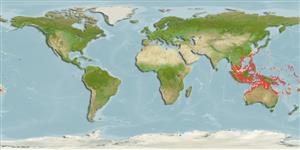Common names from other countries
>
Eupercaria/misc (Various families in series Eupercaria) >
Lutjanidae (Snappers) > Paradicichthyinae
Etymology: Symphorichthys: Greek, syn, symphysis = grown together + Greek, ichthys = fish (Ref. 45335).
More on author: Günther.
Environment: milieu / climate zone / depth range / distribution range
Ecologia
marino associati a barriera corallina; distribuzione batimetrica 5 - 60 m (Ref. 90102). Tropical; 31°N - 31°S, 98°E - 173°W
Western Pacific: Ryukyu Islands to New Caledonia and the Great Barrier Reef, including New Guinea, Sulawesi (Celebes), Admiralty Islands, Palau, and Philippines. Recently recorded from Tonga (Ref. 53797). Also known from eastern Indian Ocean from Rowley Shoals and off Broome, Western Australia.
Size / Peso / Age
Maturity: Lm ? range ? - ? cm
Max length : 60.0 cm TL maschio/sesso non determinato; (Ref. 9710); common length : 50.0 cm SL maschio/sesso non determinato; (Ref. 37816)
Spine dorsali (totale) : 10; Raggi dorsali molli (totale) : 14 - 18; Spine anali: 3; Raggi anali molli: 8 - 11.
Adults occur over sand bottoms in the vicinity of coral reefs. Usually seen singly. They feed on fishes and sand-dwelling crustaceans and mollusks. Mature individuals aggregate to spawn along seaward reefs (Ref. 9710). They are occasionally seen in markets.
Life cycle and mating behavior
Maturities | Riproduzione | Spawnings | Egg(s) | Fecundities | Larve
Allen, G.R., 1985. FAO Species Catalogue. Vol. 6. Snappers of the world. An annotated and illustrated catalogue of lutjanid species known to date. FAO Fish. Synop. 125(6):208 p. Rome: FAO. (Ref. 55)
IUCN Red List Status (Ref. 130435)
CITES (Ref. 128078)
Not Evaluated
Threat to humans
Harmless
Human uses
Pesca: scarso interesse commerciale; Acquario: Commerciale
Strumenti
Special reports
Download XML
Fonti Internet
Estimates based on models
Preferred temperature (Ref.
115969): 24.7 - 29, mean 28.1 (based on 912 cells).
Phylogenetic diversity index (Ref.
82804): PD
50 = 1.0000 [Uniqueness, from 0.5 = low to 2.0 = high].
Bayesian length-weight: a=0.01202 (0.00475 - 0.03046), b=3.03 (2.81 - 3.25), in cm Total Length, based on LWR estimates for this (Sub)family-body shape (Ref.
93245).
Trophic level (Ref.
69278): 3.8 ±0.56 se; based on food items.
Resilienza (Ref.
120179): Medio, tempo minimo di raddoppiamento della popolazione 1.4 - 4.4 anni (Preliminary K or Fecundity.).
Fishing Vulnerability (Ref.
59153): Moderate vulnerability (44 of 100).
